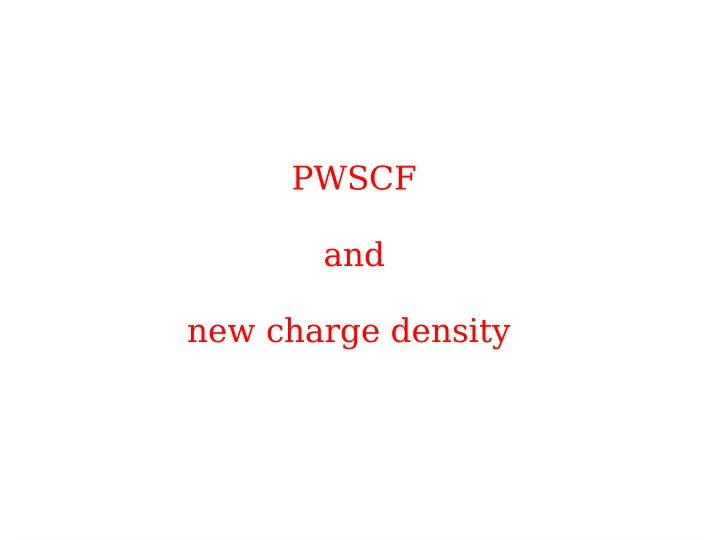

PWSCF and new charge density
PWSCF call read_input_file (input.f90) call run_pwscf call setup --> SETUP call init_run --> INIT_RUN do call electrons --> ELECTRONS call forces call stress call move_ions call update_pot call hinit1 end do
ELECTRONS call electron_scf do iter = 1, niter call c_bands --> C_BANDS call sum_band --> SUM_BAND call mix_rho call v_of_rho end do iter
SUM_BAND call weights do ik = 1, nks call get_buffer (evc) call init_us_2 (vkb) do ibnd =1, nbnd eband = eband + wg(ibnd,ik) * et(ibnd,ik) evc(igk(ig)) → psi(ir) call get_rho --> GET_RHO call sum_bec --> SUM_BEC end do ibnd end do ik call addusdens GET_RHO rho(ir) = rho(ir) + wg * |psi(ir)|**2 SUM_BEC becsum(m,m') = Sum_ik wg <psi|beta_m><beta_m'|psi>
Step 5 : new charge density
Brillouin Zone Sums Many quantities (e.g., n, Etot) involve sums over k. - In principle, need infjnite number of k’s. - In practice, sum over a fjnite number: BZ “Sampling”. - Number needed depends on band structure. - Typically need more k’s for metals. - Need to test convergence wrt k-point sampling.
Types of K-points used Special Points: [Chadi & Cohen] Points designed to give quick convergence for particular crystal structures. Monkhorst-Pack grids: Equally spaced mesh in reciprocal space. May be centred on origin [‘non-shifted’] or not [‘shifted’] K_POINTS {tpiba|crystal|automatic|gamma} If 'automatic' use M-P grids nk1, nk2, nk3, ik1, ik2, ik3 4 4 4 0 0 0 4 4 4 1 1 1 shift
Step 6 : test for convergence
How to decide if converged ? Check for self-consistency. Could compare: • New and old wavefunctions / charge densities. • New and old total energies. • Compare with energy estimated using Harris-Foulkes Input parameter conv_thr typically ok to use 1.d-8 Input parameter electron_maxstep maximum number of scf steps performed
Step 7 : mixing
Mixing Once iteration n of the self-consistent cycle has completed … how to get next guess for rho ? direct iteration in which rho_out is fed directly in rho_in rho_in(n) → rho_out t (n) → rho_in(n+1) usually doesn’t converge. One needs to mix, take some combination of input and output densities (may include information from several previous iterations). Goal is to achieve self consistency (rho_out=rho_in) in as few iterations as possible.
Mixing Simplest prescription: linear mixing rho_in(n+1) = beta * rho_out(n) + (1-beta) rho_in(n). Usually slow but should converge for small enough values of beta There exist more sophisticated prescriptions (Broyden mixing, modifjed Broyden mixing of various kinds…) based on Quasi Newton Raphson methods. Input parameter mixing_mode plain | TF| local-TF Input parameter mixing_beta - Typical values between 0.1 & 0.7 (depend on type of system)
The end : convergence achieved
Recommend
More recommend